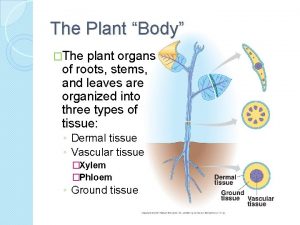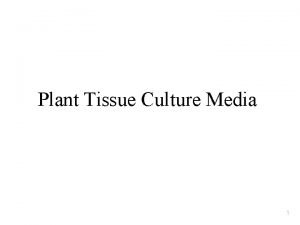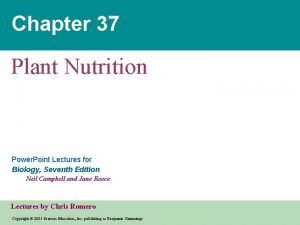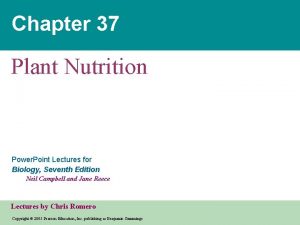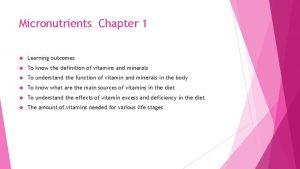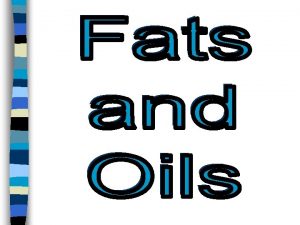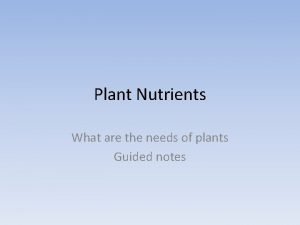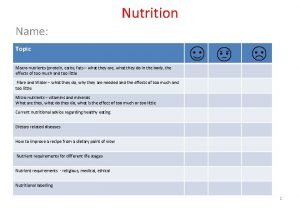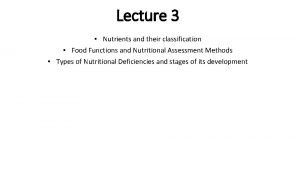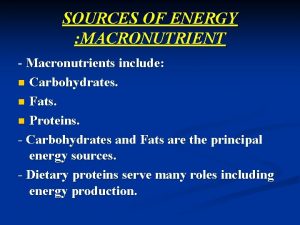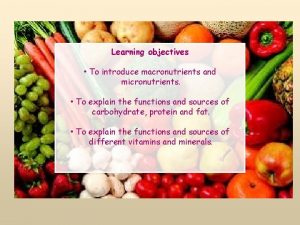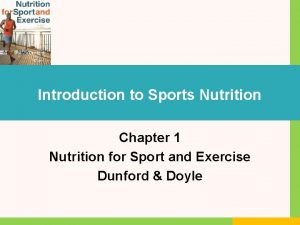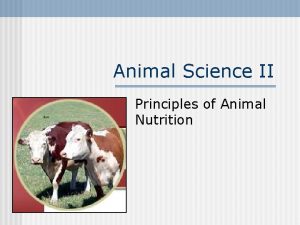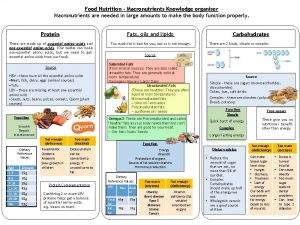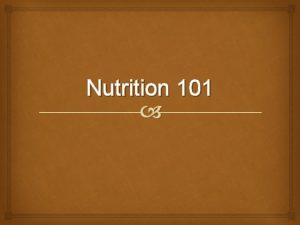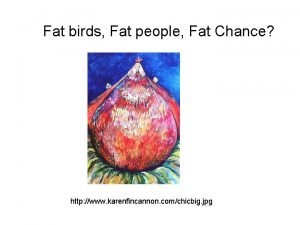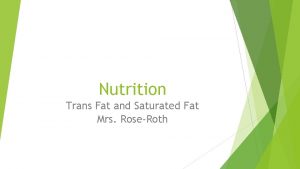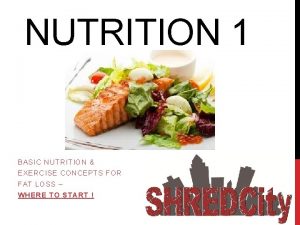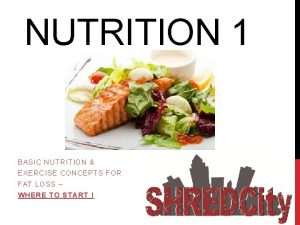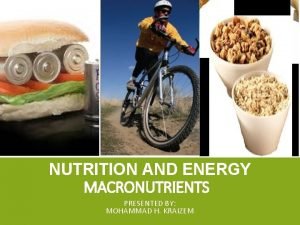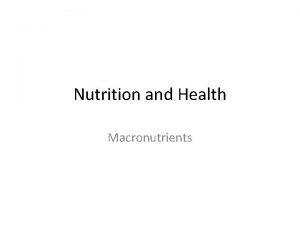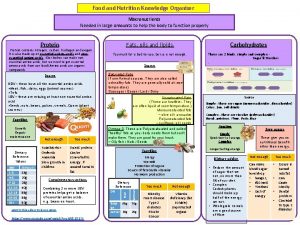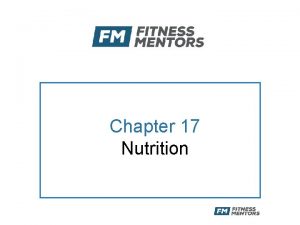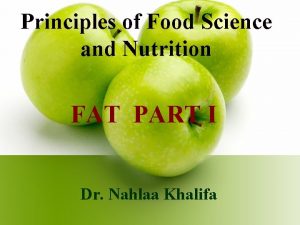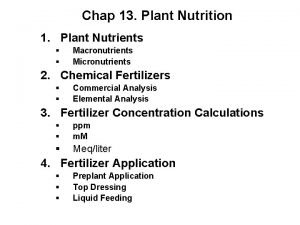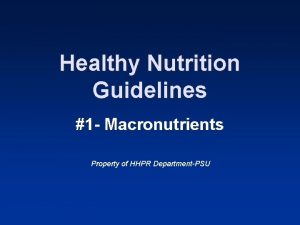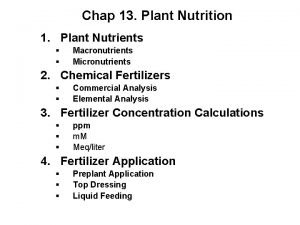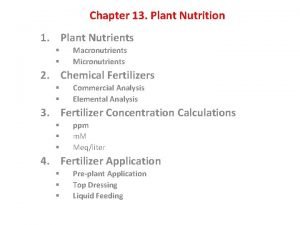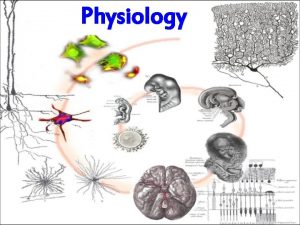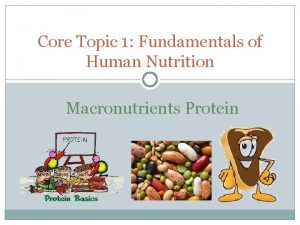Macronutrients Fat The principles of nutrition and their






















- Slides: 22

Macronutrients Fat The principles of nutrition and their application to exercise and health

Learning objectives By the end of the lesson you will be able to: • Describe the macronutrients and their functions • Evaluate good dietary sources of each macronutrient • Recognise the transport, storage and metabolised forms of each macronutrient

Nutrients for health A balanced diet requires the consumption of food from five nutrient groups (carbohydrate, protein, fat, vitamins and minerals) in varying amounts, as well as adequate water intake. These groups can then be divided into macronutrients: • Carbohydrate. • Protein. • Fat. and micronutrients: • Vitamins. • Minerals.

Functions of fat • Energy - major source of energy during lower-intensity workloads. • Transportation, storage and utilisation of fat-soluble vitamins A, D, E and K. • Formation of cell membranes. • Important component of the central nervous system and spinal cord and the formation of the myelin sheath. • Synthesis of steroid hormones. • Regulation of enzymes. • Insulation through subcutaneous adipose tissue. • Protection of internal organs.

Types of fat There are three main types of fat: • Saturated. • Monounsaturated. • Polyunsaturated. Most foods contain a mixture of all three.

Saturated fats are hard at room temperature. Common sources Animal Non-animal Fatty meat Lard Poultry Dairy Eggs Palm oil Coconut oil Cakes Pastries Biscuits Processed foods Take-away meals

Functions of saturated fat Some saturated fat should be included in the diet for: • Enhancement of the immune system. • Protection of the liver from alcohol, pesticides and other toxins. • Provision of energy. • Antimicrobial properties – fighting harmful microorganisms in our digestive tract (especially coconut oil).

Monounsaturated fat is liquid at room temperature. Sources include: • • • Olives/olive oil. Rapeseed oil. Peanut oil. Nuts (almonds, hazelnuts and peanuts are rich sources). Seeds.

Functions of monounsaturated fat Monounsaturated fats have many health-promoting benefits for the body. They help to keep the arteries clean and free from plaque by promoting the healthier type of cholesterol in the blood.

Polyunsaturated fat Sources – Oils Sunflower Vegetable Safflower Corn Polyunsaturated fats are the most easily converted into energy.

Essential fatty acids All essential fatty acids are polyunsaturated. ‘Essential’ means we cannot make them in the body in sufficient amounts and therefore have to eat them in our food. They are categorised as: Omega 3 Cod liver oil Linseeds Organic eggs Omega 6 Sunflower oil Safflower oil Vegetable oil Corn oil

Benefits of essential fatty acids Omega 3 and Omega 6 fatty acids play a fundamental role in numerous metabolic processes. They must be eaten in the required amounts to promote good health. The omega 3 fatty acids found in oily fish are particularly beneficial. They have been shown to: • Reduce the blood’s tendency to clot. • Lower blood triglyceride levels. • Lower total cholesterol levels and, in some individuals, to raise HDL (high-density lipoproteins) cholesterol. All of the above are thought to lower the risk of CHD.

Benefits of essential fatty acids • Help transport oxygen and keep red blood cells (the oxygen carriers) healthy. • Vital for the immune system, which is often challenged in people who do a lot of exercise. • Lower blood pressure in people with hypertension. • Lower risk of death, heart attack, stroke and abnormal heart rhythms in people who have already had a heart attack. • Help in reducing symptoms of rheumatoid arthritis, including joint pain and morning stiffness.

Sources of essential fatty acids • Oily fish, such as pilchards, mackerel, salmon and sardines. • Plant foods (in much smaller amounts, e. g. rapeseed, soya, flax, hemp seed and linseed oils). • Walnuts. • Pasture-reared eggs. • Oils (evening primrose, safflower oil, soybean, grapeseed, sunflower and corn oils. ) • Pumpkin seeds. • Sesame seeds.

Fats task What is the dominant type of fat found in each food product? Chicken Butter Flaxseed Herring Olive oil Margarine Pork Vegetable oil Coconut Salmon Beef Peanuts

Trans fats (hydrogenated vegetable oils) are vegetable oils which have been processed to make them hard; this also makes them less healthy, like saturated fats. Trans fats may appear on the list of ingredients as ‘partially hydrogenated vegetable fats/oil’. They are found in processed foods, such as: • Biscuits and cakes. • Ice cream and sweet syrups. • Pies and pastries. • Take-away meals. • Boxed meals and TV dinners.

Food ingredients task Collect food ingredient information from packaging. Collect the following: • Food labels. • Food packets, • Bottles with labels. • Cans with labels. • Any other packaging with ingredients listed. Analyse the ingredients and break them down into macronutrient groups and spot the trans fats in any processed foods.

Transport, storage and metabolised forms of fat Fats and oils are often referred to as lipids. Most dietary lipids consist of chains or rings of carbon atoms joined together with other atoms, most commonly hydrogen and oxygen. Lipids that are liquid at room temperature are called oils, and those which are solid are called fats. Fatty acids are the acids produced when fats are broken down during digestion. They are considered to be ‘good fats’. Fatty acids are not highly soluble in water and can be used for energy by most cell types.

Transport, storage and metabolised forms of fat Fatty acids naturally occur as triglycerides, where three fatty acids attach to a carbohydrate ‘backbone’ called glycerol. During digestion, the fatty acids are broken off and then used in the body as required. The function and behaviour of a fat is determined by the structure of fatty acid chains. Fatty acids may be saturated, monounsaturated or polyunsaturated. Dietary fat is easily stored as adipose fat in the body. It is stored throughout the body around the organs and beneath the skin. A small amount is stored in muscle. The amount stored depends on genetic make-up and individual hormone balance.

Cholesterol is a large lipid molecule produced by the liver, and it cannot be used by the body as energy. Cholesterol does not mix with the watery medium of blood, therefore the body has developed protein-based carriers called lipoproteins that enables transportation in the blood. Cholesterol is a vital component of cell membranes. Functions include: • Production of steroid hormones. • Synthesis of bile acids. • Synthesis of vitamin D.

Cholesterol is so essential to life that the liver is able to synthesise about 75 -80% of the body’s own supply. When dietary cholesterol intake is low, the body increases the synthesis of its own supply, and when dietary intake increases, cholesterol production falls. Elevated levels of total triglycerides, elevated LDL cholesterol and lower than 25% HDL cholesterol have been identified as increasing the risk of heart and circulatory problems. The desirable upper limit of total cholesterol is accepted to be 5. 2 mmol/d. L.

Learning review Can you now: • Describe the macronutrients and their functions • Evaluate good dietary sources of each macronutrient • Recognise the transport, storage and metabolised forms of each macronutrient
 Plant body parts
Plant body parts Macronutrients and micronutrients in plants
Macronutrients and micronutrients in plants Macronutrients and micronutrients in plants
Macronutrients and micronutrients in plants Macronutrients and micronutrients in plants
Macronutrients and micronutrients in plants Macronutrients and micronutrients
Macronutrients and micronutrients Vitamins functions
Vitamins functions Fat visible
Fat visible 6 macronutrients
6 macronutrients Deficiency chart of macronutrients
Deficiency chart of macronutrients What are the classification of nutrients
What are the classification of nutrients Macronutrients include
Macronutrients include Learning outcomes should be
Learning outcomes should be Trans fat vs cis fat
Trans fat vs cis fat Introduction to sports nutrition
Introduction to sports nutrition Principles of animal science
Principles of animal science Section 1 organisms and their relationships
Section 1 organisms and their relationships Principles of ecology section 3 cycling of matter
Principles of ecology section 3 cycling of matter Romeo and juliet prologue translated
Romeo and juliet prologue translated Hình ảnh bộ gõ cơ thể búng tay
Hình ảnh bộ gõ cơ thể búng tay Ng-html
Ng-html Bổ thể
Bổ thể Tỉ lệ cơ thể trẻ em
Tỉ lệ cơ thể trẻ em Chó sói
Chó sói
